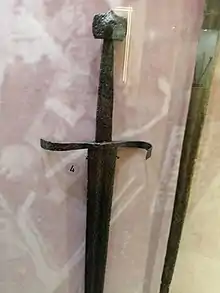Schiavonesca
Schiavonesca (in Italian: spada schiavonesca, "Slavic sword") was a type of sword characterized by a S-shaped crossguard that originated in late 14th-century Serbia and was used by knights in the Kingdom of Hungary and Republic of Venice during the 15th and 16th centuries.[1]

The Ottoman expansion and conquests saw north- and westward migrations of Serbs , initially within the Serbian state (the Serbian Despotate) and then to the neighbouring Hungary and Venetian Dalmatia.[2] In Hungary, the Serbian population was very active in defending the southern border against the Ottomans.[2] The production of this type of sword became more typologically uniform in Hungary and Venice.[2]
The oldest specimens are estimated to date to the last decades of the 14th century, a period when Serbia was in constant conflict.[2] The oldest mention is from the will of blacksmith Dobrič Bunisalić dating to 1391, held at the Ragusan Archives: "...doe spade schiavonesche...".[3]
The name originated from the Balkan Slavs who used such swords in Venetian service.[3] The term Sclavonia was the common Ragusan name for Serbia, for the most part of history its neighbouring state.[3]

References
- Aleksić 2011, Aleksić 2007
- Aleksić 2007, p. 103.
- Aleksić 2007, p. 102.
Sources
- Aleksić, Marko (2007). Mediaeval Swords from Southeastern Europe: Material from 12th to 15th Century. Belgrade: Dedraplast.
- Aleksić, Marko (2011). "Some Types of Hilts of Medieval Swords from Southeastern Europe".
- Fonseca, Cosimo Damiano (1979). Le aree omogenee della civiltà rupestre nell'ambito dell'impero bizantino - la Serbia: atti del quarto convegno internazionale di studio sulla civiltà rupestre medioevale nel mezzogiorno d'Italia. Congedo. pp. 97–98. ISBN 978-88-7786-122-1.